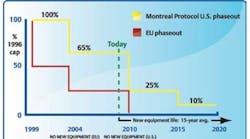The refrigeration industry has worked hard to meet regulation requirements for refrigerants. Now, faced with the phase-out of R-22, contractors will be looking at a different landscape. By 2010, the equipment that contractors install will use HFCs rather than R-22. Therefore, refrigeration and air conditioning contractors will need to know how to accurately install and service HFC-based equipment.
Although this transition will be impactful, refrigeration contractors seem to be on board with the change and willing to move forward by preparing to learn more about equipment that uses the HFC alternatives.
“As contractors, we’re trying to be proactive in our move away from R-22,” according to Mark Drango, director of service operations, Fazio Mechanical Services, Inc., Sharpsburg, PA.
“This move to HFCs makes absolute sense because customers are naturally trying to drive down their costs and environmental impact,” Drango says.
In 2008, Emerson Climate Technologies conducted a survey of more than 300 refrigeration contractors, and asked their thoughts and plans on refrigerants. More than half the contractors surveyed said that they would likely continue to install at least some R-22 systems in the coming year, although most said they have begun the transition to the HFC alternatives.
When asked whether they were comfortable with using several refrigerants at a service location, 77% of those contractors surveyed were comfortable with the idea, even if it meant using different refrigerants for service and new equipment. As a result of the upcoming changes, refrigeration contractors need to be more informed than ever with regard to HFCs and the installation and maintenance of equipment that uses HFC refrigerants.
HCFC-22 Phase-Out
Regulations state that in 2010, refrigerant manufacturers will no longer be able to produce R-22 for use in new equipment. They will still be able to produce R-22 for service needs. After 2020, the only source of R-22 will be from reclamation and recycling. Figure 1 shows the phase-out schedule for the U.S. and the European Union (E.U.).
The Environmental Protection Agency (EPA) predicts that shortages of R-22 may appear by 2015, which might reduce availability and increase prices. Refrigeration contractors need to be prepared for the possibility of R-22 retrofits to HFCs in existing equipment prior to 2015.
Alternative Solutions — HFCs
Refrigerant manufacturers have responded to the upcoming R-22 phaseout with several safe and cost-effective HFC solutions for new equipment. HFCs are non-ozone-depleting, nonflammable, recyclable and energy-efficient refrigerants of low toxicity that are used worldwide. Properly designed and maintained refrigeration systems using HFC refrigerants provide the lowest total global warming potential, as well as zero ozone depletion. With end-users having an interest in finding refrigeration equipment with the smallest carbon footprint, HFCs are often the best solution.
There are various types of HFC refrigerants used by original equipment manufacturers (OEMs). Some HFCs are pure refrigerants. Others are mixtures or blends of different single-component refrigerants. For example, R-134a is a pure refrigerant. R-404A and R-410A are HFC blends. Blends allow the advantage of tailoring the final refrigerant characteristics for efficiency, performance and reliability.
With 2010 approaching, refrigeration and air conditioning contractors should be aware of the following pure and blended HFC refrigerants for HVACR equipment:
R-410A. R-410A is becoming a popular choice for air conditioning systems because of its high efficiency. R-410A operates at 50% higher pressure than R-22, so anyone handling these units should receive training on the technical aspects of the new R-410A systems. R-410A cannot be used as a retrofit refrigerant with existing equipment; it should only be used in new equipment (including compressors) specifically designed for R-410A.
R-134a. R-134a is used in many small, medium, and high temperature refrigeration systems such as ice machines and reach-ins, as well as large chillers and air conditiong and process cooling systems. It has characteristics similar to R-12, but R-134a has low capacity compared to R-22. It’s typically not used to retrofit systems, except for some large commercial screw or centrifugal systems.
R-404A and R-507. HFC refrigerants R-404A and R-507 have been chosen by equipment manufacturers as the longterm replacement for R-502. Both are excellent low- and medium temperature refrigerants, due to high energy efficiency and zero-ozone-depletion potential. These refrigerants are commercially available from numerous sources and are becoming the most popular refrigerants in this class.
R-407C. Of the higher-temperature HFC options, R-407C was designed to have operating characteristics similar to R-22. The major concerns surrounding R-407C are in its relatively high glide (approximately 8F) and the efficiency degradation when compared to R-22.
Care should be taken when using R-407C in any applications in which glide can impact system performance by fractionation in flooded-evaporator or multi-evaporator designs. Like all HFCs, R-407C requires the use of POE lubricants, and other system design modifications may be required for R-407C to operate acceptably in R-22 systems.
R-407A. R-407A is an HFC refrigerant being promoted for new equipment, primarily as an alternative to R-502 in supermarket refrigeration and for some R-22 applications. There may be special application considerations for low temperature applications. Manufacturing guidelines should be consulted.
R-422 refrigerants. R-422A/B/C/D are HFC refrigerants developed to replace R-22. R-422 is only approved for certain refrigeration systems with oil separators. Refrigerant changeover guidelines are available from Emerson that describe the retrofit procedures when transitioning from R-22 to R-422 series refrigerants.
As a result of the benefits of HFCs, many manufacturers, including Emerson Climate Technologies, recommend that HFCs be specified in all new refrigeration equipment. OEMs have also already begun their evaluation of specific HFC preferences for new equipment. R-404A, R-507 and R-134A are the top choices for refrigeration equipment, and R-410A has been selected by OEMs as the optimum HFC for air conditioning equipment.
Manufacturers suggest that contractors follow specific guidelines when retrofitting R-22 equipment. To ensure proper, efficient equipment operation, they should strictly follow manufacturers’ recommendations (i.e., For Emerson Climate Technologies this means only R-407C with POE oil for retrofitting R-22 A/C equipment and R-404A with POE oil or R-422A or R-422D with mineral oil for certain refrigeration equipment).
Effectively Managing HFCs
With the change to HFCs, contractors also need to be prepared for HFC equipment installation and maintenance. To best manage equipment using HFC refrigerants, contractors should increase responsible use efforts to lower leak rates and enhance recordkeeping, containment, reclamation, and recycling practices. Recognizing how important HFCs are to the future of commercial refrigeration, the EPA and The Alliance for Responsible Atmospheric Policy (www.arap.org) published “Responsible Use Principles for HFCs.” The document identifies the following areas for responsible use: • contain refrigerants in tight or closed systems and containers, minimizing atmospheric releases • encourage monitoring after installations to minimize direct refrigerant emissions and to maintain energy efficiency • train personnel in proper refrigerant handling • comply with standards on refrigerant safety, proper installation and maintenance (e.g., ASHRAE-15 and ISO- 5149) • design, select, install and operate to optimize energy efficiency • recover, recycle and reclaim refrigerants • continue to improve equipment energy efficiency when cost effective.
Leak Reduction and Containment
Unless the industry can effectively address leak rates, many fear that HFCs could go the way of CFCs and HCFCs. Contractors need to work with equipment manufacturers to lower leaks in HCFC and HFC systems. To do their part, equipment manufacturers are working to design systems that require less charge and have fewer leaks.
Contractors are responsible for properly containing the refrigerant and testing refrigeration equipment to ensure that it’s in compliance with EPA Sec. 608 leak repair rules. Contractors should also use Standard 147 of the American Society of Heating, Refrigerating, and Air- Conditioning Engineers (ASHRAE) as a guideline for servicing equipment and minimizing leaks.
Many contractors are doing their part to keep leaks to a minimum. “Leak detection is one of the top priorities for commercial refrigeration companies,” says Drango. “As contractors, we should be looking for the latest, improved means to find, repair, and contain leaks as quickly and efficiently as possible.” By doing this, and educating store operators about EPA leak rules and regulations, contractors can cut service refrigerant usage and help end-users avoid regulation violations and fines.
Maintenance
Prompt maintenance is important in keeping systems running longer and more efficiently. Preventive maintenance routines can also help extend the life of equipment and raise energy efficiency.
Recovery, Recycling and Reclamation
As part of the Responsible Use Initiative, Air-Conditioning, Heating, and Refrigeration Institute (AHRI) is promoting a program to provide financial incentives for reclaiming or destroying used refrigerants. The goal of Refrigerant Management USA (RMUSA) is to increase the amount of reclaimed, recycled, or destroyed refrigerant and reduce refrigerant leaks.
Record Keeping
Contractors can offer refrigerant management services to customers by organizing their refrigerant inventory information. This is essential documentation that the owners need for compliance with the EPA’s Clean Air Act. Contractors should record the equipment identification, date of service, the amount and type of refrigerant added to the system, and the full charge size of the system.
Software programs can help track refrigerant data for management, analysis, and reporting. Information on HFCs and the proper tools and tips for effectively managing them, will help refrigeration contractors be better prepared for the transition. By working together to implement these regulations, manufacturers and contractors can ensure that the transition is seamless, effective and successful.
Warren Beeton is vice president of engineering, Emerson Climate Technologies, refrigeration division.










